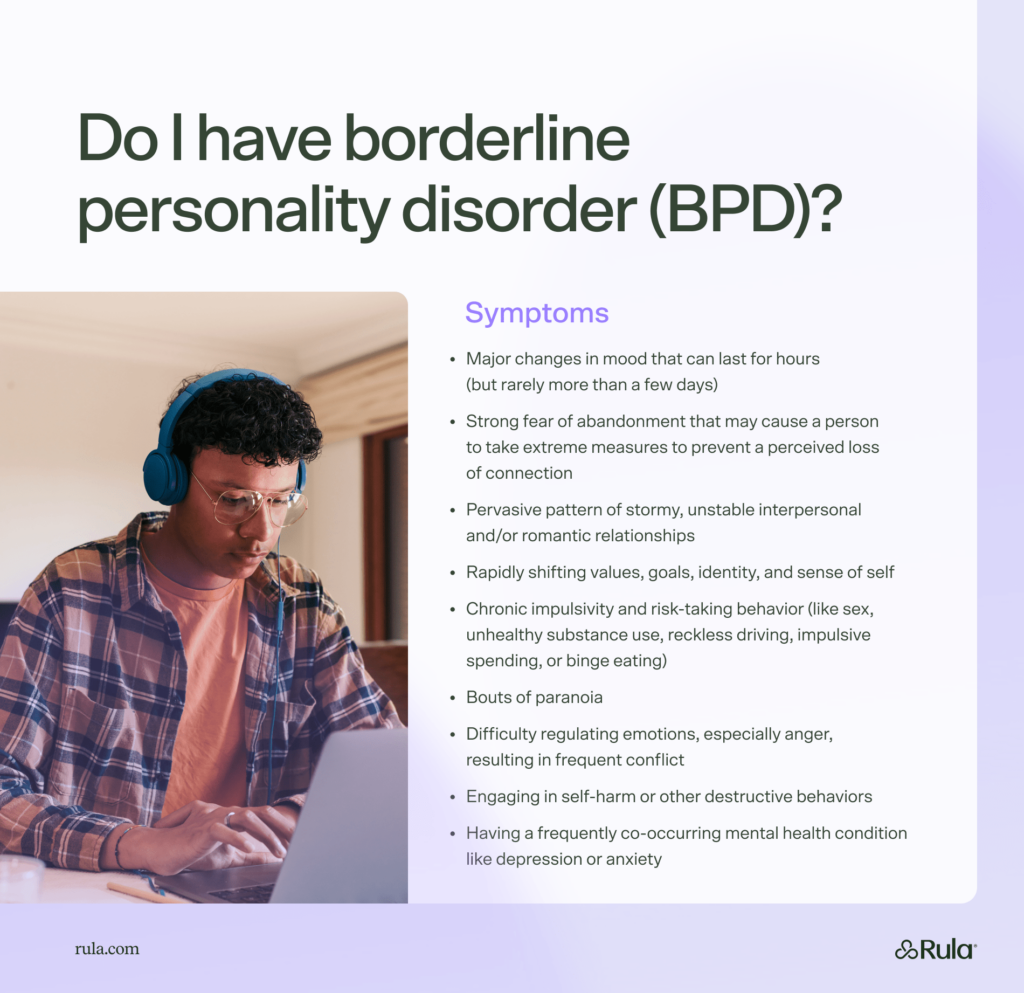Borderline personality disorder (BPD) is a mental illness that can impact your thoughts, feelings, behaviors, and sense of self.
People living with BPD may experience intense mood swings, chronic instability, a deep fear of abandonment, and difficulty maintaining relationships. BPD can lead to impulsivity and high-risk behavior that could compromise a person’s safety.
If you’re concerned that you might have BPD, the best thing to do is seek a professional evaluation from a mental health professional. They can provide a formal diagnosis and create a treatment plan to help you regain control of your life.
According to the National Alliance on Mental Illness, less than 2% of the adult U.S. population experiences borderline personality disorder (BPD). Of people who are diagnosed with BPD, about 75% are women. However, some research suggests that men may struggle with BPD at similar rates but are often misdiagnosed with other mental health concerns like major depression or post-traumatic stress disorder (PTSD).
BPD is known to cause emotional instability and volatility in relationships. So like other mental health concerns, BPD doesn’t just affect the person with the diagnosis. Left untreated, BPD can take a toll on families, friends, and other meaningful relationships. But fortunately, with the right support, people living with this condition can manage their symptoms, connect with others, and live rich, fulfilling lives.
What is BPD?
BPD is a mental health condition that requires a professional diagnosis. It is known to profoundly impact the way you see yourself and the way you relate to other people. BPD typically arises in early adulthood and often causes a deep fear of abandonment, impulsivity, extreme anger, impulsiveness, and frequent mood swings. Together, these symptoms can have a destabilizing effect that can make it difficult to function in daily life.
The care you need, when you need it
Learn how Rula can support your mental health journey
What causes BPD?
Like other mental health disorders, the causes of BPD aren’t fully understood. But some research indicates that there are some genetic and environmental factors that might put you at a higher risk for developing the condition, including:
Problems with the way the brain regulates chemicals, specifically serotonin
Irregular development of certain parts of the brain
Surviving a traumatic childhood involving abuse or parental neglect
Growing up in a home where you witnessed a serious mental illness and/or substance misuse
Having a first-degree relative who also has BPD

What are the symptoms of BPD?
BPD is a mental health condition that is characterized by mood swings, impulsive behavior, and instability in relationships. While BPD can manifest in different ways, depending on the individual, there are some known signs and symptoms.
Major changes in mood that can last for hours (but rarely more than a few days)
Strong fear of abandonment that may cause a person to take extreme measures to prevent a perceived loss of connection
Pervasive pattern of stormy, unstable interpersonal and/or romantic relationships
Rapidly shifting values, goals, identity, and sense of self
Chronic impulsivity and risk-taking behavior (like sex, unhealthy substance use, reckless driving, impulsive spending, or binge eating)
Bouts of paranoia
Difficulty regulating emotions, especially anger, resulting in frequent conflict
Engaging in self-harm or other destructive behaviors
Having a frequently co-occurring mental health condition like anxiety or depression
Note: Without treatment, people living with BPD are at serious risk for self-injury and suicide. If you or someone you care about is in crisis, or you just need someone to talk to, contact the Suicide and Crisis Lifeline by dialing 988 from any phone. This free, confidential resource provides 24/7 support.
What can I expect when being evaluated by a provider for BPD?
One of the first and most important steps in getting treatment for BPD is getting an evaluation from a mental health professional. While you may have encountered some “borderline personality disorder tests” online, there’s no replacement for a professional diagnosis. Unlike those self-evaluations, a therapist can review your history, help you track your symptoms, and co-create a treatment plan to reduce your symptoms and keep you safe.
If you’ve never worked with a therapist before, you might be wondering what you can expect when being evaluated for BPD. BPD is a complex condition that shares many key features with other mental illnesses.
So your provider will need some time to get to know you and your history before making a formal diagnosis. In your first few sessions, they’ll ask about your personal and family history, when you started experiencing symptoms, and what you’ve tried so far to manage them. Your therapist may also suggest that you receive a medical evaluation to rule out any underlying physiological concerns.
While there isn’t a lab or blood test that can reveal whether or not someone has BPD, there are a few formal evaluation tools your provider may use to better understand your symptoms. But ultimately, your provider will consult the Diagnostic Statistical Manual of Mental Disorders (DSM-5) to ensure an accurate diagnosis.
How Rula can help with BPD
If you think you may have BPD, it’s important to seek professional help as soon as possible. While the experience of living with BPD can be difficult, the right treatment can help you find relief and manage your symptoms.
Using Rula, you can quickly find a therapist who’s in-network with your insurance who treats BPD. Our platform is designed to take the confusion out of accessing treatment and make it easy to attend sessions virtually from the comfort of your home.
And since our teletherapy platform also includes psychiatric services, we can also connect you with a provider who can help you with medication management if that’s part of your care plan. To learn more about getting help for BPD with Rula, check out our website.
Trauma and PTSD therapists near you
New York, NY – Houston, TX – Rancho Cucamonga, CA – Austin, TX – Chicago, IL – Los Angeles, CA – Columbus, OH – Portland, OR – Dallas, TX – Jacksonville, FL – Charlotte, NC – Denver, CO – Huntsville, AL – Philadelphia, PA – Seattle, WA – Find your city
Rula's editorial process
Rula's editorial team is on a mission to make science-backed mental health insights accessible and practical for every person seeking to better understand or improve mental wellness.
Members of Rula’s clinical leadership team and other expert providers contribute to all published content, offering guidance on themes and insights based on their firsthand experience in the field. Every piece of content is thoroughly reviewed by a clinician before publishing.





